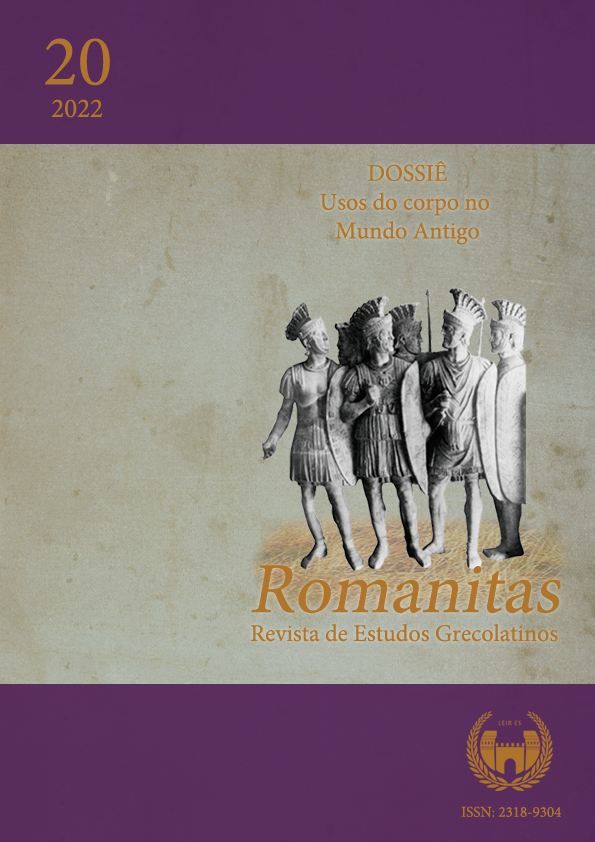Tradição geográfica e recepção: a 'Geografia', de Estrabão, no contexto do Principado
DOI:
https://doi.org/10.29327/2345891.20.20-9Palavras-chave:
Império Romano, Geografia, Estrabão, Tradição, RecepçãoResumo
A Geografia, de Estrabão, escrita entre os séculos I a.C. e I d.C., é uma obra composta por dezessete livros, nos quais o autor reuniu uma série de informações a respeito das regiões banhadas pelo Mediterrâneo. Por meio da Geografia, acessamos dados acerca da natureza local (clima, relevo, solo, rios, animais e plantas), dos aspectos etnográficos (aparência física, usos e costumes, vestimentas e organização da sociedade), bem como das narrativas mitológicas e de eventos históricos. Neste artigo, apresentamos aspectos relacionados à produção, à tradição geográfica, ao público-alvo e à recepção da Geografia. Sendo assim, a partir de nossa análise, veremos como Estrabão dialogava com seus antecessores, além de ter sido influenciado diretamente pelo contexto no qual vivia.
Downloads
Referências
Documentação textual
ESTRABÃO. Geografia: Livro III. Introdução, tradução e notas de Jorge Deserto e Susana da Hora Marques. Coimbra: Imprensa da Universidade de Coimbra, 2016.
STRABO. The Geography of Strabo: Books 1-2. Translated by Horace Leonard Jones. London: Loeb Classical Library, 1960.
STRABO. The Geography of Strabo: Books 3-5. Translated by Horace Leonard Jones. London: Loeb Classical Library, 1960.
Obras de apoio
AUJAC, G.; LASSERRE, F. Introduction générale. In: STRABON. Géographie: introductión générale et Livre I. Paris: Belles Lettres, 1969, p. vii-xcvii.
BLÁZQUEZ MARTÍNEZ, J. M. La Hispania en época de Augusto vista por escritores contemporáneos: Estrabón y Trogo Pompeyo. Gerión, v. 24, n. 1, p. 237-249, 2006.
CLARKE, K. Between Geography and History: Hellenistic constructions of the Roman World. Oxford: Oxford University Press, 1999.
DANDROW, E. Ethnography and identity in Strabo’s Geography. In: DUECK, D. (ed.). The Routledge companion to Strabo. New York: Routledge, 2017, p. 113-124.
DESERTO, J.; MARQUES, S. H. Introdução. In: ESTRABÃO. Geografia: Livro III. Coimbra: Imprensa da Universidade de Coimbra, 2016, p. 13-31.
DUECK, D. Strabo of Amasia: a Greek man of letters in Augustan Rome. London: Routledge, 2000.
GRIMAL, P. Dicionário da mitologia grega e romana. Rio de Janeiro: Bertrand Brasil, 2005.
LEITE, L. R. Difusão e recepção das obras literárias em Roma. In: SILVA, G. V.; LEITE, L. R. (org.). As múltiplas faces do discurso em Roma: textos, inscrições, imagens. Vitória: Edufes, 2013, p. 82-98.
POTHECARY, S. The European provinces: Strabo as evidence. In: DUECK, D.; LINDSAY, H.; POTHECARY, S. (ed.). Strabo’s cultural Geography: the making of a kolossourgia. Cambridge: Cambridge University Press, 2005, p. 161-179.
SILVA, G. A. Estrabão e o domínio romano sobre a Ibéria: um estudo à luz dos conceitos de isotopia e heterotopia (27 a.C. – 23 d.C.). Dissertação (Mestrado em História) – Programa de Pós-Graduação em História da Universidade Federal do Espírito Santo, Vitória, 2021.
SØRENSEN, S. L. “So says Strabo”: the reception of Strabo’s work in Antiquity. In: DUECK, D. (ed.). The Routledge companion to Strabo. New York: Routledge, 2017, p. 355-366.
ZULIANI, F. M. Passado e presente em Estrabão: as estruturas espaço-temporais da Geografia e suas relações com o Império Romano. Dissertação (Mestrado em História) – Programa de Pós-Graduação em História Econômica da Universidade de São Paulo, São Paulo, 1999.
Downloads
Publicado
Edição
Seção
Licença
Copyright (c) 2023 Guilherme de Aquino Silva

Este trabalho está licenciado sob uma licença Creative Commons Attribution-NonCommercial-NoDerivatives 4.0 International License.
a. Os autores mantêm os direitos autorais e concedem à revista o direito de primeira publicação.
b. Os autores têm autorização para assumir contratos adicionais separadamente, para distribuição não-exclusiva da versão do trabalho publicada nesta revista (ex.: publicar em repositório institucional ou como capítulo de livro), com reconhecimento de autoria e publicação inicial nesta revista.
c. Autores têm permissão e são estimulados a publicar e distribuir seu trabalho online (ex.: em repositórios institucionais ou na sua página pessoal) após a primeira publicação pela revista, com os devidos créditos.
d. Os textos da revista estão licenciados com uma Licença CC BY 4.0 Deed Atribuição 4.0 Internacional (CC BY).




























